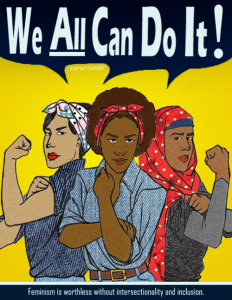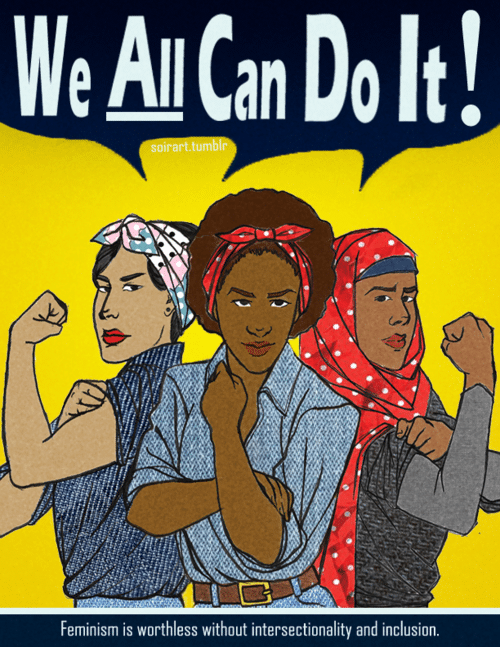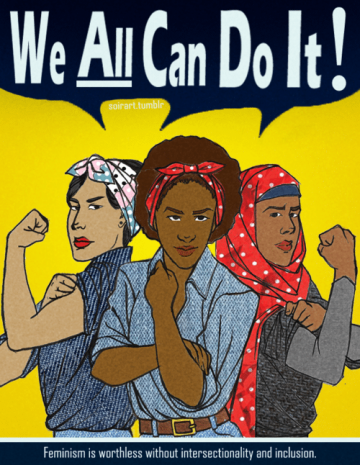 Jessica Finnigan, Kari Waters, and Nancy Ross wrote this paper for the Mormon History Association annual conference in 2015. The full text of the talk is provided here.
Jessica Finnigan, Kari Waters, and Nancy Ross wrote this paper for the Mormon History Association annual conference in 2015. The full text of the talk is provided here.
Many individuals, both inside and outside of the LDS Church, have criticized, characterized, and demonized Mormon feminists. Secular feminists on the left accuse Mormon feminists of having failed to reject patriarchal religion and fellow believers on the right denounce them as being pseudo-Mormons who reject God’s appointed patriarchal order. We believe that Mormon feminists are caught in the middle of these two extremes as a result of historical problems. Today they are not given the space to identify themselves and their own individual positions, always mischaracterized in as being on the wrong side of a false dichotomy.
Second wave feminists, also called “modern” or “secular” feminists, dismissed patriarchal religion and assumed that it would disappear in a more enlightened society (Klassen 2009). Many of these feminists, like Simone de Beauvoir, had difficult relationships with organized religion and moved away from it in their early years (Thurman 2010). Some, like Virginia Woolf, grew to detest religion and Christianity in particular (Knight 2007). In later feminist works, many of these women describe religion only in terms of patriarchy and they way that patriarchy oppresses women. These claims had merit, but they reduced the narrative of women in religion to a simple story of oppression. This narrative led Second Wave feminists to ignore the work of early feminists who were religious, as well as marginalize women who chose to be religious even after Second Wave feminists had, in their minds, proven that religion was patriarchal and harmful. This led to an erasure of some feminists’ religious identities within the broader feminist movement. This erasure has spilled into popular feminism online. Numerous online overviews of feminism, citing scholarly articles, ignore religious feminists or the religious identities of some feminists.
The work done by Second Wave feminists shaped the discourse on feminism and a product of this secular feminism was a large gap with religious feminists. This discourse created binary view of religion and feminism where they existed on opposite ends of a spectrum. Unfortunately, this idea has spilled into both popular and academic feminism today. Numerous online overviews of feminism, citing scholarly articles, ignore religious feminists or the religious identity of some historical feminists. Today, religious feminists are often presented as a paradox, with the assumption that it would be impossible for a person to embrace both the ideas of feminism and the tenets of a conservative religion (Basquiat 2001; Bell 1976; Dodwell 2003; Stack 1991). Some even suggest that any gender advances in religion are owed to secular feminism (Jones 2012).
The disparaging views of religion by prominent Second Wave feminists not only impacted the way religious women are viewed in academic literature and in the media, but how feminism is viewed within religious communities today. Mark Chaves (1999) noted that a church’s stance on women’s issues is often a signifier of their progressive or conservative positions. He observed that a church that constructs its institutional identity in terms of tradition and conservatism will likely reject gender reform on the basis that gender reform is evidence of secularism and progressivism. In this way, women’s issues are transformed into political issues. Chaves also noted that attempts to initiate gender reform may result in an anti-modernist and anti-secular backlash. We believe that this is an issue within the LDS Church today, as many traditional members see Mormon feminists as apostates, with no opportunity for overlap. It is this contested space that religious feminists must negotiate.
This binary of feminist apostate vs. faithful conservative is overly reductive. We would like to expand on an idea posited by Paul Malan in a February 2015 blog post. He used the metaphor of an ecosystem to illustrate the complex organizational processes within Mormonism. Within his essay Malan (2015) highlights the benefits and costs of maintaining a monoculture and the risks of expanding and embracing the complexity diversity. In the post, he explains that on the planet there exist biomes, where only one kind of ecosystem can thrive, whether it be grassland, forest, or something else. At the edges, called ecotones, there are a diversity of species that cannot exists within the biomes that surround the ecotone, or even without the biomes. And while biomes are certainly very productive in nature, they are also fragile as they can be entirely destroyed if a new species is introduced. The ecotones on the other hand are more flexible because of their diversity. Because of the gendered nature of organizational and ritual authority in the LDS Church, we believe that Mormonism is a male ecosystem, a monoculture that allowed men to thrive. Claudia Bushman echoes this idea in her recent essay for the Exponent II magazine. She wrote:
I always say, and I do believe, that the effort has been to build up men rather than to oppress women. But the effect of reigning in the auxiliaries and of placing them firmly under the direction of the priesthood has been to lessen responsibility and opportunity for women. (Bushman 2015)
The male ecosystem of Mormonism has profound effects of the experiences of Mormon women, however individual women respond to it. Women are asked to understand themselves from a man’s point of view. Discussions of women and their bodies do not include the variety of their lived experiences. Within this monoculture, gender problems become politicized and part of the in group/out group dynamics of Mormonism. In other words, if you are a woman and think that there are problems with the way that women are treated in the church, you are a faithless troublemaker and if you are a woman and think that there are no problems with the way that women are treated in the church, you are deemed to be righteous and faithful.
Even with words to express these lived experiences, Mormon feminists and more traditional members have a hard time understanding each others points of view. These problems are not limited to religious feminists and their more conservative counterparts. In an attempt to explain why liberals and conservatives continue to talk past each other, Haidt and Graham (2007) proposed what they call the Moral Foundations Theory. This theoretical framework suggests that there are five moral foundations that people base their judgments and behavior on: harm/care, fairness/reciprocity, in-group/loyalty, authority/respect and purity/sanctity. They proposed that those who consider themselves liberal base their judgments on the first two foundations: harm/care and fairness/reciprocity, while those who call themselves conservative use all five foundations. These different perspectives make it difficult for the two sides to understand each other (Haidt and Graham, 2007). We think that Moral Foundations Theory helps explain why religious feminists and more traditional church members struggle to empathize with each other. Conservative members feel that religious feminists are ignoring the moral foundations they feel strongly about, including their beliefs about authority, while religious feminists feel their ideas about fairness are being marginalized and ignored.
Another source of misunderstanding between religious feminists and more traditional members comes from stereotyping done by both groups. In a study about how liberals and conservatives stereotype each other, Graham, Nosek, and Haidt (2012) suggest that opposing sides underestimate how much the other side shares their values. Each side also overestimates how extreme a socalled typical member of their group is. In fact, the stereotyping that existed within the group was sometimes even more extreme than the stereotyping that happened outside of the group. Liberals were likely to hyperbolize what other liberals believed just as conservatives were likely to hyperbolize what other conservatives believed. Graham, Nosek, and Haidt propose that this phenomenon may be unique to moral values, as those exaggerating the morals want to ensure that these moral values are in line with the group’s moral values (Graham, Nosek, Haidt, 2012).
We suggest that this same phenomenon exists within Mormon culture and Mormon feminism. More traditional members may believe that Mormon feminists are more extreme than they actually are while at the same time over emphasizing the more conservative elements of church teachings. Mormon feminists may sometimes believe that no one wants them at church, even if they consider themselves to be a moderate Mormon feminist. In reality, most members actually believe something in the middle.
There is evidence to suggest that most Mormons engage in a process of negotiation that results in more middle-ground thinking than we might expect of a highly conservative group. The qualitative data from the Mormon Gender Issues Survey, a study of which will be available in a forthcoming book chapter, clearly showed that the (mostly American) Mormons we surveyed thought about gender in complex terms that integrated church teaching with their lived experiences (Finnigan and Ross 2015), resulting in mixed views about the treatment of women in the church. This data differed from the more straightforward quantitative data that asked people to select – responses to questions about gender in the church. When you ask a conservative Mormon a multiple choice question about the treatment of women in the LDS Church, you will likely elicit a response that affirms the status quo. When you ask that same individual to explain herself, you will get a more complex answer that is not necessarily aligned with the response from multiple choice question.
As a result of the data analysis from this survey, my colleagues and I developed Negotiation Theory, or the idea that most religious people will find a way to integrate religious teaching into their lived experiences and that this process produces their understanding of gender and religion. If we use negotiation theory to understand what Mormons think and believe about gender in the church, we will likely find that many or most members occupy some sort of middle ground. Many will find elements of church teaching and policy on gender to be beneficial to women, but those same individuals will also point out ways in which church teaching and policy are not beneficial to women. Conservative Mormons and progressive Mormons, including Mormon feminists, engage in this process. The negotiation process is largely influenced by life experiences and so that leads members to take more conservative or more liberal stances. In this way, Mormon feminists are just doing what other Mormons do but reaching different conclusions as they negotiate gender in the church. More awareness that we all participate in this process but reach different conclusions according to our life experiences would go a long way to build understanding between more traditional and feminist Mormons.
When we operate exclusively in a binary or monoculture mode, our framework excludes everyone who disagrees with us. In order to understand Mormon feminists as Mormons, we need to reject the binary framework. Our disagreements do not necessarily stem from differences in belief, but differences in lived experiences and the way that we negotiate those experiences with church teaching. Mormon males look at the ecosystem that was designed to help them thrive, and if they thrive, they tend to see the ecosystem as divine. But I look at the way that this system benefits men at the expense of women and I struggle to see that as a complete reflection of God’s will. To create a church where leaders listen, acknowledge, and make space for women, including Mormon feminists, we need to transition away from the male monoculture. Personal and spiritual success are not scarce and we should not fear women and men thriving together in a church with greater biodiversity.
Works Cited
Basquiat, Jennifer Huss. 2001. “Reproducing Patriarchy and Erasing Feminism: The Selective Construction of History Within the Mormon Community.” Journal of Feminist Studies in Religion 17: 5– 37.
Bell, Elouise. 1976. “The Implications of Feminism for BYU.” BYU Studies 16: 527-540.
Bushman, Claudia. 2015. Living and Writing History. Exponent II vol 34, no 3, 12.
Chaves, Mark. 1999. Ordaining Women: Culture and Conflict in Religious Organizations. Harvard University Press.
Dodwell, Karen. 2003. “Marketing and Teaching a Women’s Literature Course to Culturally Conservative Students.” Feminist Teacher 14: 234– 247.
Finnigan, Jessica and Nancy Ross 2015. Mormon Feminists in Social Media: A story of community and education. Gordon Shepherd, Gary Shepherd, and Lavina Fielding 8 Anderson (eds). Voices for Equality: Ordain Women and Resurgent Mormon Feminism. Greg Kofford Books. 335-354.
Graham, J., Nosek, B. A., & Haidt, J. (2012). The moral stereotypes of liberals and conservatives: Exaggeration of differences across the political spectrum. PLoS ONE, 7, e42366.
Klassen, Chris. 2009. Feminist Spirituality and ThirdWave Feminism. Chris Klassen (ed). Feminist Spirituality: The Next Generation. Lexington Books.
Jones, Nelson. 2012. “What the church owes to secular feminism.” New Statesman. http://www.newstatesman.com/nelsonjones/2012/10/whatchurchowessecularfeminism
Knight, Christopher J. 2007. “The God of love is full of tricks”: Virginia Woolf’s Vexed Relation to the Tradition of Christianity. Religion and Literature 39:1, 27-46.
Malan, Paul. “Wetlands: The Future of Mormonism.” Medium. Accessed March 6, 2015. https://medium.com/@ungewissen/wetlandsthefutureofmormonismf1c1b3b62256.
Stack, Peggy Fletcher. 1991. “ Mormonism and Feminism?” Wilson Quarterly 15:30 – 32.
Thurman, Judith. 2010. Introduction to Simone de Beauvoir’s The Second Sex. Excerpt published in The New York Times 27 May 2010.




7 Responses
Thank you for this posting.
A thank you from me too. This was very helpful in giving me a perspective on the various definitions and points of view. There are elements I find difficult to come to terms with, but this was very useful for me.
Thanks. This provides a lot of talking points for Mormon feminists to communicate our mission to other feminists.
There are several problems facing Mormon feminists, in my opinion. One of them is the label itself. Unfortunately that brings up a negative connotation, not only with some men, maybe too many men, but with maybe more than a few women
Many women that are comfortable with the “traditional” view feel attacked by some members of the Mormon feminist movement. And in actuality they are. I have seen it in several of the blogs by some of the more strident ladies that have taken upon themselves of the label “mormon feminist.”
That brings up a another problem. There is no one definition that fits “mormon feminist.” If one peruses the different blogs, no common theme can be discerned, except for a dissatisfaction with the status quo. There are some who are mormon in name only, having pretty much completely lost their faith during their journey, while there are others who struggle with the problems that their perceptions of the status quo cause but remain believers to a greater or lesser extent. There are some that are willing to debate the issues on equal terms with a male, but others who will accept no input from a male unless it is in agreement with the current mores of whatever the group is.
I don’t even know how my words will be accepted here because I am fairly certain that I am a male, although old geezer might fit better.
Glenn
This is really interesting stuff. Thanks for posting it! I particularly like the comparison to Haidt’s work and the point that we (Mormon feminists and traditional Mormons) probably have more in common than we think.
I love the validation, too, that coming through this negotiated place is something that everyone has done. Perhaps we followed different paths, but the act of negotiating itself isn’t evidence that I have fallen off of a one-true-road.
One day I’ll make it to one of these conferences. I’m so glad we could read this, and experience some of the growth and enlightenment available to participants.
Do you know if Claudia Bushman’s article is available online, or only through back issue? Bushman, Claudia. 2015. Living and Writing History. Exponent II vol 34, no 3